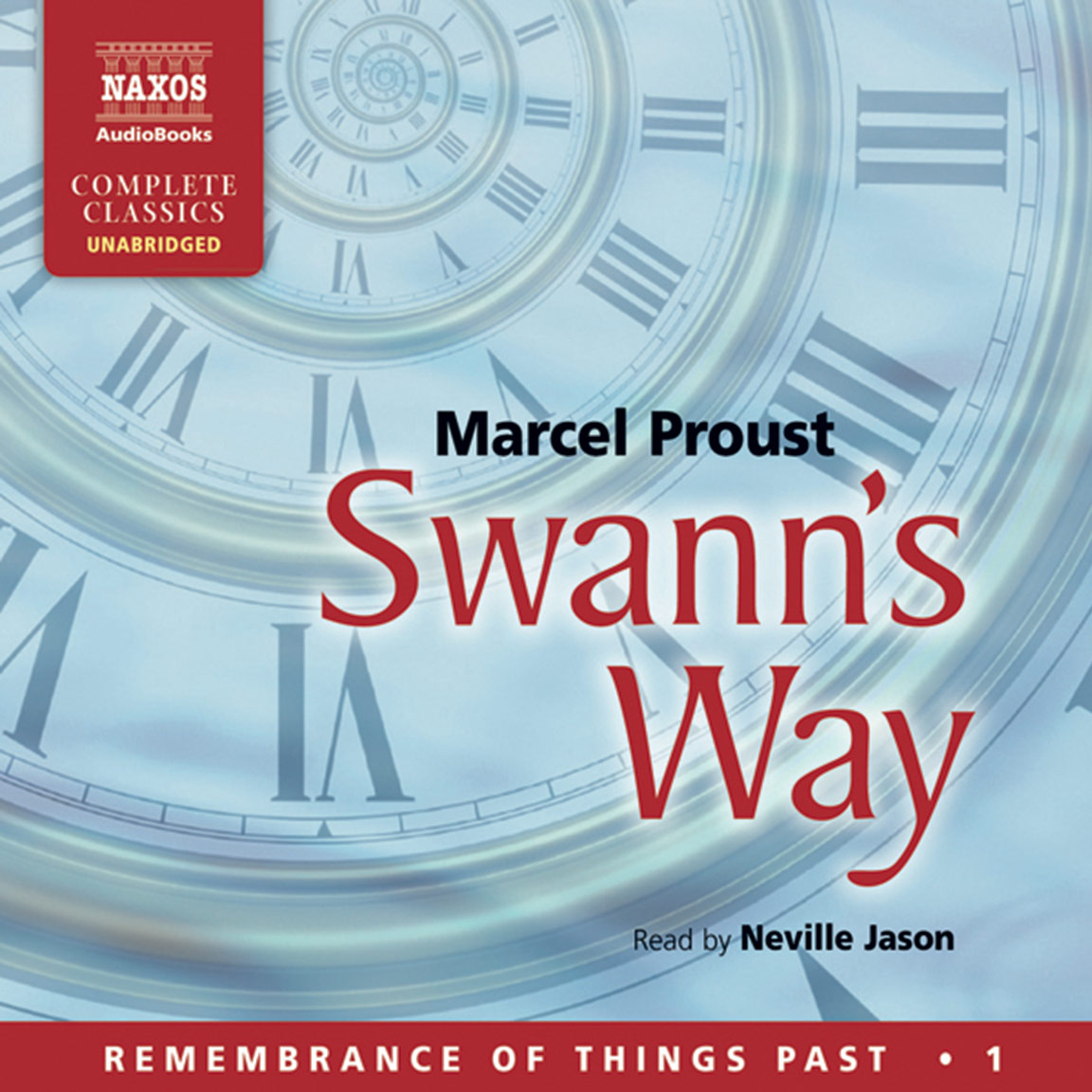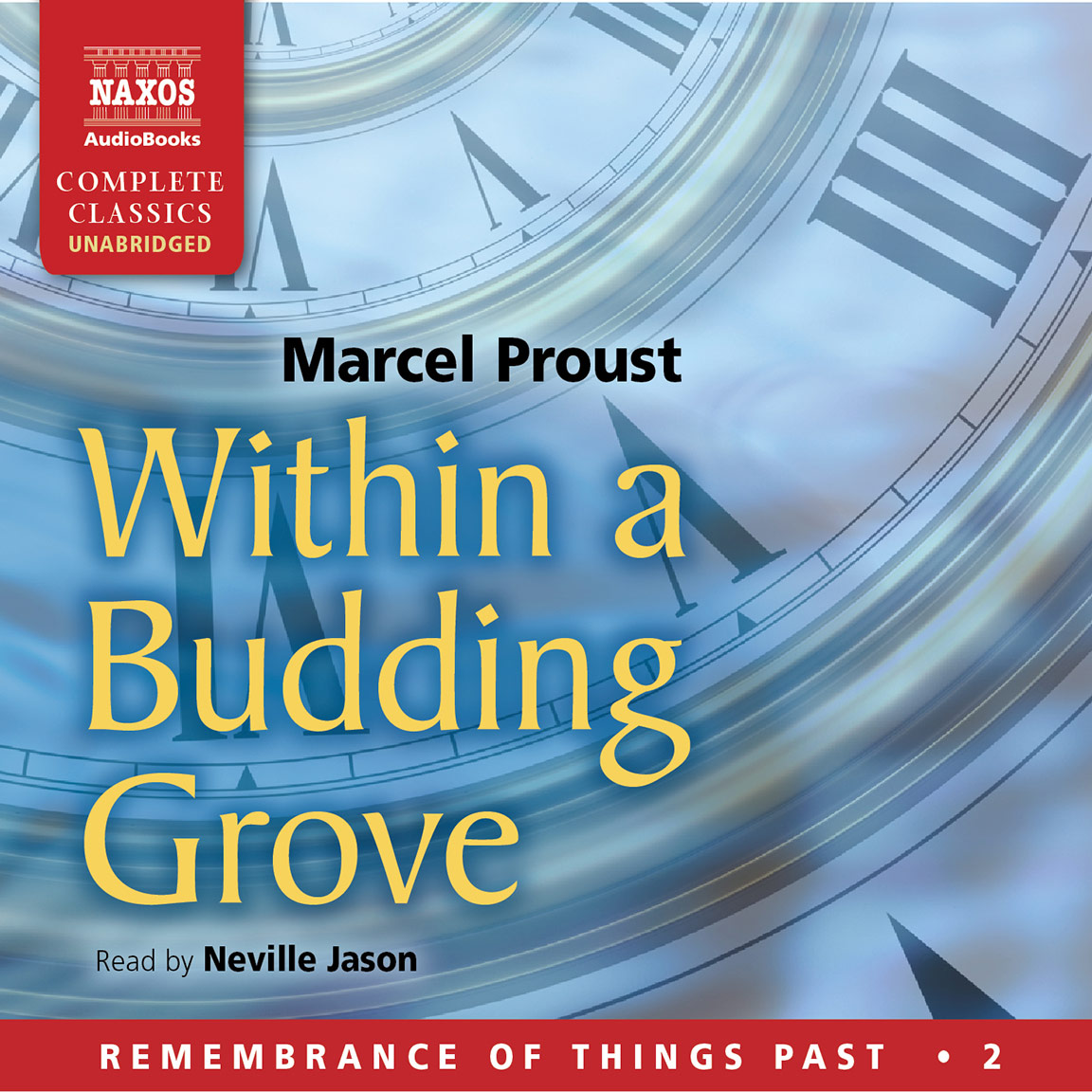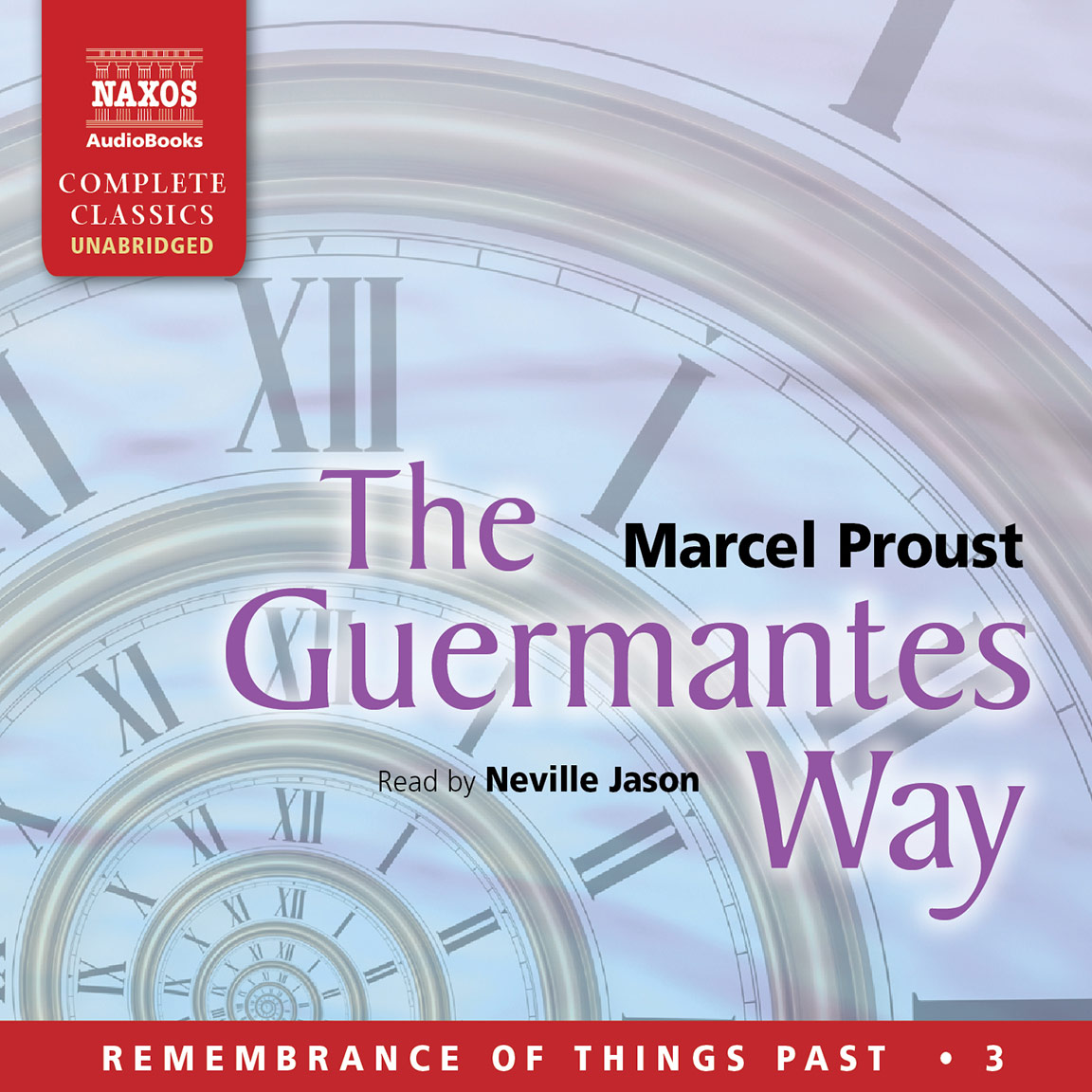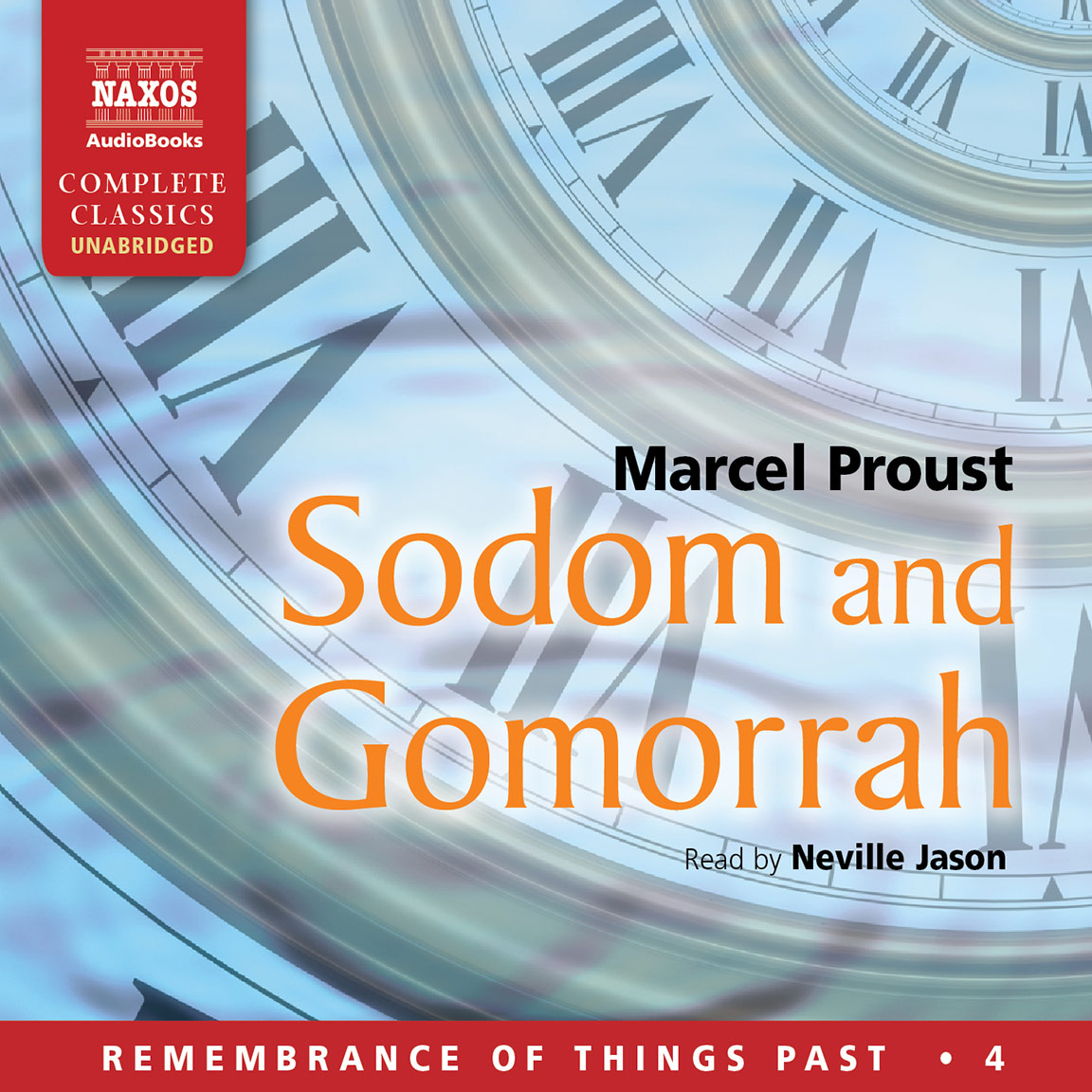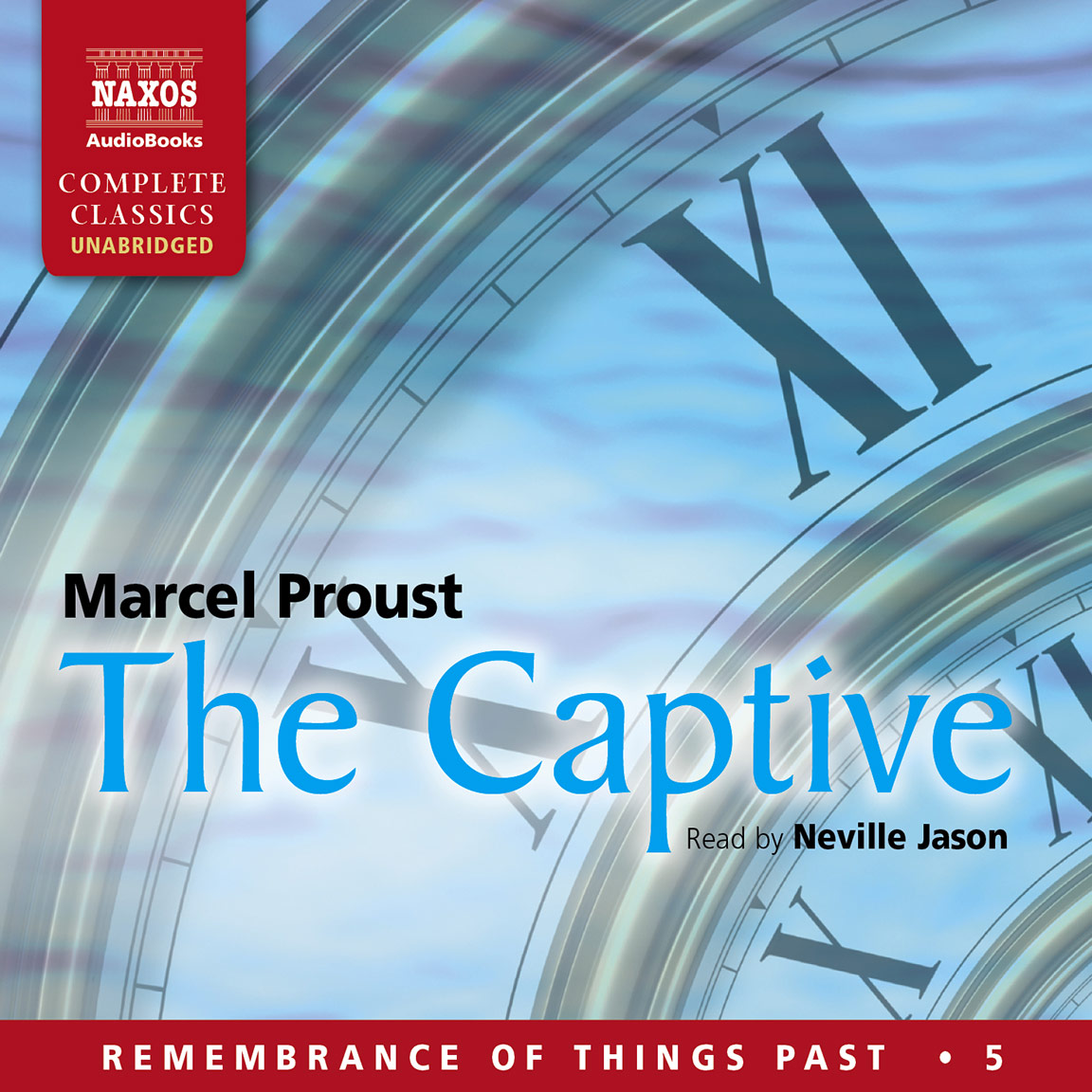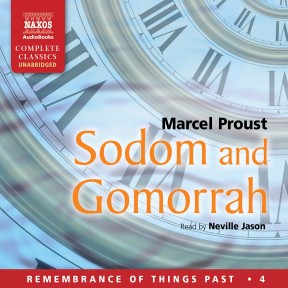
Audio Sample
Marcel Proust
Sodom and Gomorrah
Read by Neville Jason
unabridged
Remembrance of Things Past is one of the monuments of 20th-century literature. Neville Jason’s unabridged recording of the work runs to 150 hours. Sodom and Gomorrah is the fourth of seven volumes. Accidentally witnessing an encounter between the Baron de Charlus and the tailor Jupien, the narrator’s eyes are opened to a world hidden from him until now; he suspects that Albertine is attracted to her own sex. Based on the translation by C. K. Scott Moncrieff.
-
Running Time: 26 h 04 m
More product details
Digital ISBN: 978-1-84379-613-8 Cat. no.: NA0099 Download size: 746 MB Translated by: C. K. Scott Moncrieff BISAC: FIC000000 Released: June 2012 -
Listen to this title at Audible.com↗Listen to this title at the Naxos Spoken Word Library↗
Due to copyright, this title is not currently available in your region.
You May Also Enjoy
Booklet Notes
The critic André Maurois described Proust’s Remembrance of Things Past as ‘one of the greatest works of the imagination of all time’.
The literal translation of the work’s French title, ‘In Search of Lost Time’, contains within it a clue to the creation of this monumental work of biographical fiction. Having wasted time living a dilettante existence in the fashionable world, Proust, in middle age, decided to re-dedicate his life to art, and to attempt at last to achieve the great work of which he knew himself capable.
Remembrance of Things Past was his chance to justify his life, and to cheat death through an act of artistic creation. It was the means he would use to conquer time through recreating his lost years. Memory was the material with which he would weave the magic cord to be launched into infinity; that cord which now binds us to him, and stretches forward into the future, linking his genius to unborn generations.
The Author
Marcel Proust was born on 10 July, 1871. His father, a distinguished professor of medicine, was from a Catholic family, while his mother was Jewish. Although convinced from an early age of his calling as a writer, Proust was riddled with self-doubt and wrote relatively little at the beginning of his career.
During his twenties, he co-founded a short-lived review, Le Banquet; contributed to another literary publication, La Revue Blanche; and in 1896 had his first book published, a collection of essays entitled Les Plaisirs et Les Jours.
He became an enthusiastic admirer of Ruskin and translated his Bible of Amiens and Sesame and Lilies into French. A novel, Jean Santeuil, which was the precursor of Remembrance of Things Past, was abandoned, and eventually published long after Proust’s death, in 1954.
For much of his youth Proust led the life of a man-about-town, frequenting fashionable Paris drawing rooms and literary salons, which were to form the background of a number of his early stories and sketches, and subsequently of Remembrance of Things Past.
The death of his adored mother in 1905 resulted in a nervous collapse and aggravated his chronic asthma and insomnia. But, despite his grief and the sense of loss, from which he never recovered, his mother’s death freed him with regard to his homosexual way of life, and allowed him to address same-sex love in his writing, albeit in a form which treated such experiences as happening to others rather than to himself.
In 1907 he moved into an apartment in the Boulevard Haussmann where, in the bedroom which he had had lined with cork to keep out noise, he embarked upon his great work À la Recherche du Temps Perdu (Remembrance of Things Past). In it the minuteness of his observation, the depth of his psychological understanding and the vividness of his descriptive powers combined to create one of the most poetic and magical works in all literature.
Publication of Remembrance of Things Past
This long autobiographical cycle was originally published in eight sections: Du Côté de Chez Swann (Swann’s Way) in 1913; A L’Ombre des Jeunes Filles en Fleurs (Within a Budding Grove) in 1918; Le Côté de Guermantes I (The Guermantes Way I) in 1920; Le Côté de Guermantes II and Sodom et Gomorrhe I (Cities of the Plain I) in 1921; Sodom et Gomorrhe II in 1922; La Prisonnière (The Captive) in 1923; Albertine Disparue (The Sweet Cheat Gone/The Fugitive) in 1925 and Le Temps Retrouvé (Time Regained) in 1927.
Proust was obliged to publish Swann’s Way at his own expense, and even after it had appeared, had trouble finding a publisher for the next part, A L’Ombre des Jeunes Filles en Fleurs. However, when it appeared in 1918 it received considerable acclaim, and was awarded the Prix Goncourt the following year.
By the time Proust died, on 18 November, 1922, the first four parts of the cycle had been published, leaving the others to appear posthumously.
Sodom and Gomorrah – Part I
Sodom and Gomorrah (Cities of the Plain) Part I opens with the Narrator, Marcel, awaiting the return of the Duke and Duchess of Guermantes in the Hotel de Guermantes, their mansion in Paris, in which Marcel’s family occupies an apartment. The ducal premises also provide accommodation for Madame de Villeparisis, aunt of the Duke and Duchess, while on a lower level, both architecturally and socially, the tailor Jupien runs his business with the help of his niece.
The Duke’s brother, the Baron de Charlus, arrives to visit Madame de Villeparisis, and finding her out or indisposed, is about to leave when he finds himself confronted by Jupien.
Their meeting provides the occasion for Marcel to witness a homosexual encounter which opens his eyes to the Baron’s sexual proclivities, and enlightens him regarding de Charlus’s hitherto inexplicable behaviour towards himself. It also affords the author the opportunity of drawing a skilful and witty parallel between a horticultural and a human conjunction, as Marcel’s absorption in the scene betweem Charlus and Jupien leads to his missing the possible fertilisation of the Duchess’s orchid, which has been left out in the courtyard in the hope of attracting the attentions of a passing bee.
In this way, Proust introduces us to the theme of homosexuality, male and female, announced in the title. It is a subject on which Proust speaks with an understanding and sympathy born of his own homosexual way of life, which he felt obliged to keep secret, and which he carefully disguises in his autobiographical novel, where the Narrator, who is undoubtedly based on Proust himself, falls in love only with women.
Proust scholars and researchers have identified female characters in the book as disguised versions of men with whom Proust had had love affairs, although it is also suggested that his relationships with certain women are unlikely to have been entirely platonic. However, these speculations are of interest principally in explaining the depth of understanding Proust shows in his exposition of the theme of same-sex love, and his sympathy for the pain and frustration it causes those whose sexual nature is condemned by society and who are obliged to live lives of secrecy and duplicity.
There is particular poignancy in Proust’s reference to ‘sons without a mother, to whom they are obliged to lie all her life long and even in the hour when they close her dying eyes’, in view of his own need to hide his private life from his adored mother, and to his description of ‘the poet who one day was feasted at every table, applauded in every theatre in London, and on the next was driven from every lodging, unable to find a pillow upon which to lay his head’, a clear reference to Oscar Wilde, who had been a friend of the young Proust, and was then living out the remains of his life as an exile in Paris.
And perhaps it is as well for those who would condemn Proust for his lack of openness regarding his sexuality, to be reminded of the distance society has travelled since his lifetime, and of the legal punishment and social ostracism which then awaited those who were known to transgress the accepted norms of sexual behaviour.
If the activities of the Baron de Charlus serve as an introduction to the world of Sodom, it is the Narrator’s love for Albertine which takes us into the realm of Gomorrah, or female homosexuality.
The subject of unrequited love is no novelty in literature, and yet in Proust’s hands it is fashioned anew. It would be a remarkable psychologist who was able to analyse Proust more perceptively than he analyses himself.
He unerringly connects the painful sense of exclusion Marcel feels when he fears Albertine does not love him, with the childhood experience of his mother’s refusal at Combray to give him the benediction of her goodnight kiss. Here is the classic Oedipal situation in which his wish to have his mother entirely to himself is thwarted by the existence of his father.
Adding to the pain which is felt by every rejected lover is the knowledge that he has no chance of possessing Albertine if his suspicions about her ‘Sapphism’ are confirmed. He would, in that case, be constitutionally unable ever to satisfy her desires.
If it is true, as has been suggested, that the character of Albertine is a disguised version of Proust’s real life male lover, the author’s own situation will be seen as equally impossible – that of a man in love with a man who preferred women. And it is Proust’s personal experience of an anguished yearning for love he can never obtain which invests his fictional study with such compelling authenticity.
But not only Oedipal frustration and gender preference stand between the Narrator/Proust and the unconditional love he craves, there is also that last and greatest obstacle of them all – death. On the occasion of his second visit to Balbec, memories of the first visit undertaken in the company of his grandmother suddenly overwhelm Marcel, and he is faced for the first time with the irreversible reality of the death of the person who, after his mother, he loved most in the world.
Here again Proust displays the depth of his psychological insight as he charts Marcel’s slow progress from despair to resignation in observing the workings of his unconscious mind through the medium of his dreams.
Once more the reader is privileged to witness the miracle performed by the author of turning the events of his transient life into an enduring work of art.
Sodom and Gomorrah – Part II
Part II continues the story of the Narrator Marcel’s second visit to the coastal visit of Balbec, where he makes further discoveries relating to the homosexual behaviour of his acquaintances.
The ageing Baron de Charlus, in love with the gifted but unscrupulous violinist Charles Morel, continues to search for casual sexual encounters elsewhere and dines openly at the hotel with a Duchess’s footman. Morel, apparently bisexual, either gives or withholds his favours from male admirers, according to how it will benefit him. Bloch’s uncle M. Nissim Bernard, infatuated with a young waiter, mistakes the young man’s identical twin, who does not share his brother’s sexual taste, for the object of his passion, with disastrous results. The Prince de Guermantes, whom we have previously met at a brilliant ball given by him and his wife in their mansion, the magnificent Hotel de Guermantes, engages the services of Morel in the somewhat less salubrious surroundings of a seaside brothel, once again with unforeseen and hilarious consequences.
These episodes are at once both comic and tragic. In other hands they might be the stuff of a Feydeau-style farce. But Proust is no farceur. Whilst he has a keen appreciation of the humour implicit in these situations, he is too sensitive and complex an artist not to be aware of their dark side. He knows too well the pain of being forced to hide his sexual nature, even from those dearest to him, and the loneliness of feeling different from other men. Humour is there, but tempered with compassion for the powerlessness of men swept away by a passion which, in a society which permits them no outlet, becomes so urgent it breaches the barriers of their lives and precipitates them into ludicrous and embarrassing situations.
Female homosexuality, for the Narrator, has no such comic side. In the face of his love for Albertine it exists as a terrible threat against which he is powerless. As long as he feels Albertine is faithful to him he is able to consider parting with her, but once she is revealed as a lover of women, he is tormented with the passionate need to make her his own.
For Marcel the Narrator, as in the case of Marcel his creator, is one of those doomed to yearn after phantoms. The incident in his childhood, recounted in Swann’s Way, where he refuses to go to sleep until his mother comes to kiss him goodnight, and then is granted more than his wish when his father allows her to spend the night in his room, creates a terrible tension between the desire to have his mother to himself, and the guilt and fear caused by having his wish to exclude his father granted. This powerful Oedipal struggle has set up a subconscious need to repeat the painful experience endlessly in a vain effort to try to come to terms with it.
In real life, Proust’s passionate attachment to his mother appears to have led to psychosomatic illness, homosexual desire, and the inability to form lasting and satisfactory relationships. When his fictional alter ego falls in love with Albertine, he unconsciously chooses a woman with homosexual desires, and therefore one incapable of giving herself completely to him. As he imagines her caressing other women, or hears her over the telephone enjoying herself with her friends in a café, he suffers the same painful sense of exclusion – of the woman he loves enjoying herself with others rather than with him – that he felt as a child lying in bed on a summer’s night with the window open, listening to the sounds of chatting and laughter wafting up to him, whilst his mother entertained guests in the garden below.
Whilst homosexuality is the principal theme of Sodom and Gomorrah, it is by no means the only one, and Proust’s fascination with human behaviour finds much to interest him in other sections of society, particularly in the bohemian circle of M. and Mme Verdurin, which has moved down to the seaside for the summer. Proust paints a vividly observant picture of the little clique of ‘the faithful’, held together by its overbearing ‘Mistress’ who lives in terror of being abandoned by its members. He shows us the cruelty of M. Verdurin as he tortures the awkward and diffident Saniette, the social pretensions of Mme Verdurin for whom ‘bores’ become ‘amusing’ once they begin to attend her Wednesdays, the arrogance of the local aristocracy who consider they do her a favour in accepting her invitations, the affectation of the ‘faithful’ who pride themselves on being artistically ‘advanced’, and their pretence that they have rejected other salons, which in reality they would have no chance of entering, in favour of this one.
All this is presented by the Narrator with a lack of condemnation. He not only observes the faults and pretensions of others, but is not afraid to acknowledge them in himself. Proust holds up a mirror to us in which we cannot help but see our own image. In his flawed characters we recognise ourselves, and are obliged to accept that, in our own way, we all possess our share of human failings.
The Life and Work of Marcel Proust
To avoid any confusion, it may be helpful to point out that Proust’s great work, À La Recherche du Temps Perdu, was originally translated into English by Charles K. Scott-Moncrieff and published in 1922 under the title Remembrance of Things Past. It was subsequently re-translated by Terence Kilmartin and appeared in 1981 as In Search of Lost Time. In 2002 a new edition appeared under the same title, with each volume assigned to a different translator. The Naxos AudioBooks recordings use the Scott-Moncrieff text and, in references to the work, I use Scott-Moncrieff’s title.
My own contact with Proust began when, as a 17-year-old schoolboy, I first read Swann’s Way. I could not have guessed then that, many years into the future, Proust would take over my life to such an extent. Over a six year period during the 1990s, I abridged and recorded Remembrance of Things Past for Naxos AudioBooks, for whom I have now recorded this entire, uncut text.
When I was asked to write The Life and Work of Marcel Proust (see www.naxosaudiobooks.com), it occurred to me that, although the people on whom Proust based his characters were no longer living, the places he wrote about were still there, and so I travelled to France to see them.
I was delighted to discover that Illiers, where Marcel Proust spent his holidays as a child, and which figures in the book as Combray, is now marked on maps and road signs as Illiers-Combray, in official recognition of the reason for this sleepy village’s wider fame.
In a narrow street just off the market square in Illiers-Combray is the house in which Proust’s father, Adrien Proust, was born, and further along is the house of his aunt Élisabeth, now a Proust museum, where Élisabeth’s fictional counterpart, the bedridden Aunt Léonie, watched the world go by from her bedroom window. Around the corner from the house is a little boulangerie with a sign in the window announcing proudly: ‘This is where Aunt Léonie bought her madeleines’. It only occurs to me as I buy a packet of the scallop-shaped cakes, that Aunt Léonie is a creature of fiction. Never mind, Aunt Élisabeth might well have patronised the establishment, or one very like it. Up the hill there is a real house called Tansonville, the name of the house occupied by Charles Swann, and later by his daughter Gilberte and her husband Robert de Saint-Loup, and further on there is a real village called Méréglise, a name almost identical to the fictional Méséglise.
Water lilies are still reflected in the glassy surface of the river Loir, which in the book bears the more poetic name the Vivonne, and beyond the stream lies the Pré Catalan, the enchanting park created by Proust’s horticulturally minded Uncle Jules. From Illiers I travelled on to Cabourg, a seaside resort on the Normandy coast, the original of the fictional Balbec. Here I found the Grand Hotel in all its Edwardian splendour. It was rebuilt after Proust spent holidays there as a child, but he returned as an adult, and sections of Remembrance of Things Past were written beneath its roof. As in Within a Budding Grove, the great glass windows of the restaurant look out over the promenade to the beach below, and with a little imagination, that group of budding young girls in bikinis is transformed into the little band of ‘jeunes filles en fleurs’ outlined against the sea.
I travelled on to Paris, visiting 102 Boulevard Haussmann, Proust’s home for many years, where he wrote so much of Remembrance of Things Past. The building is still owned by the same bank that purchased it from Proust’s aunt, when her inconsiderate decision to sell it forced him to move. His bedroom is still there, but unfurnished, and to see the room as it was, one is obliged to visit the Musée Carnavalet, where his bed, chaise-longue and other effects are displayed in a reconstruction of the famous cork-lined room.
A walk to the gardens of the Champs Élysées brought me to an area with a sign announcing that I am in the Allée Marcel Proust. Children chase each other – perhaps playing the modern equivalent of ‘prisoners base’, the game played by Gilberte and her friends. This is where the real Marcel played as a child with the real Marie de Benardaky, with whom he fell in love, just as the fictional Marcel falls in love with the fictional Gilberte Swann.
In the real world the same spaces are occupied now by different people. Time has moved on, but places remain, and we have the privilege of being present in not only the imaginary world Proust created, but that portion of the real world which had a part in its creation. His presence has left behind a trace of magic, and we see places differently, because we see them through his eyes. One day those places will have crumbled into dust, as will we ourselves, and the space we now consider ours will be occupied by others. But as long as civilisation remains, those who come after us will be able to share Proust’s vision and enter his world. Proust was aware that art is the only true reality, and that through his creations the artist continues to live after his death, beyond space and beyond time.
Notes by Neville Jason
A Proust Chronology
1871, July 10 – Marcel Proust born
1873, May 24 – Robert Proust born
1878–1886 – holiday visits to Illiers (now Illiers-Combray)
1880, spring – Marcel’s first attack of asthma
1882–1888 – attends the Lycée Condorcet
1888 – contributed to La Revue Lilas and La Revue Verte
1889–1890 – military service at Orléans
1890, January 3 – death of maternal grandmother, Adèle Weil
1890, August – holiday at Cabourg
1890, November – enrols as a student in the Faculty of Law and at the Ecole Libre des Sciences Politiques
1890, November – 1891, September – contributes to Le Mensuel
1892, March – first edition of Le Banquet
1893, March – last edition of Le Banquet
1893, April 13 – meets Comte Robert de Montesquiou-Fezensac
1893 – contributes to La Revue Blanche; degree in law
1894, May 22 – meets Reynaldo Hahn
1894, December – trial of Captain Alfred Dreyfus
1895, March – degree in philosophy
1895, summer – holiday in Brittany with Reynaldo Hahn
1896 – publication of Les Plaisirs et Les Jours; writing Jean Santeuil
1897, February 6 – duel with Jean Lorrain
1898, January 13 – Emile Zola’s article J’Accuse published
1899 – begins translation of Ruskin’s Our Fathers Have Told Us (La Bible d’Amiens)
1899, summer – holiday at Evian-les-Bains, visits the Brancovan family at Amphion
1900, June and October – visits Venice
1902 – abandons work on Jean Santeuil
1903, November 26 – death of Adrien Proust
1904 – publication of La Bible d’Amiens
1905, September 26 – death of Jeanne Proust
1906, June – publication of Sesame and Lilies (Sésame et les Lys)
1906, July – Dreyfus declared innocent
1906, December – moves to 102 Boulevard Haussmann
1907, summer – holiday at Cabourg, where he will spend the next seven summers. Meets Alfred Agostinelli
1908–09 – begins writing À la Recherche du Temps Perdu
1913 – Agostinelli re-enters Proust’s life. Employs Celeste Albaret
1913, November – Du Côté de Chez Swann (Swann’s Way) published
1914, May 30 – Alfred Agostinelli dies in an aircraft accident
1918, June – publication of A L’Ombre des Jeunes Filles en Fleurs (Within a Budding Grove), Pastiches et Melanges and new edition of Swann’s Way
1919, June – moves to 8, rue Laurent-Pichat
1919, December – Within a Budding Grove awarded the Prix Goncourt
1920, October – moves to 44, rue Hamelin
1920, October – Le Côté de Guermantes I (The Guermantes Way I) published
1920, April – Le Côté de Guermantes II and Sodom et Gomorrhe I (Cities of the Plain I) published
1921, December 11 – death of Montesquiou
1922, April – Sodom et Gomorrhe II published
1922, October – awarded the Légion d’Honneur
1922, November 18 – death of Marcel Proust
1923 – La Prisonnière (The Captive) published
1925 – Albertine Disparue (The Fugitive/The Sweet Cheat Gone) published
1952 – Jean Santeuil published
1954 – Contre Sainte-Beuve (Against Sainte-Beuve) published

